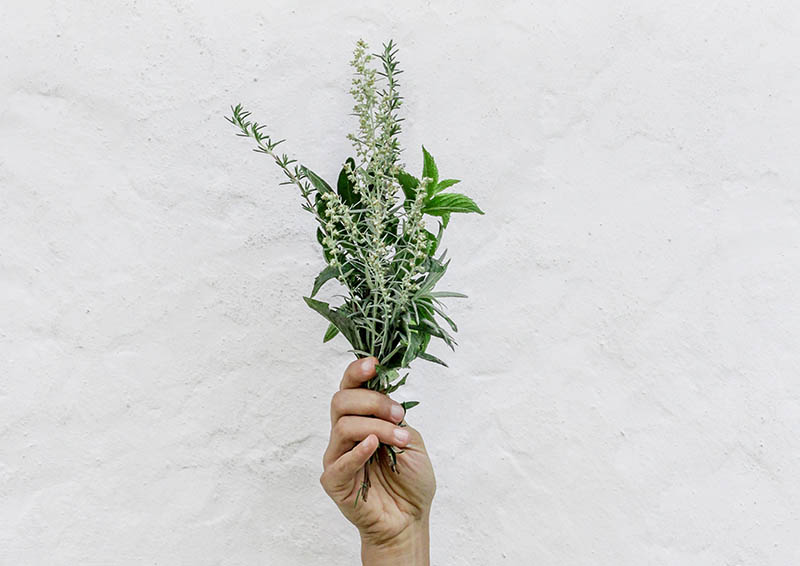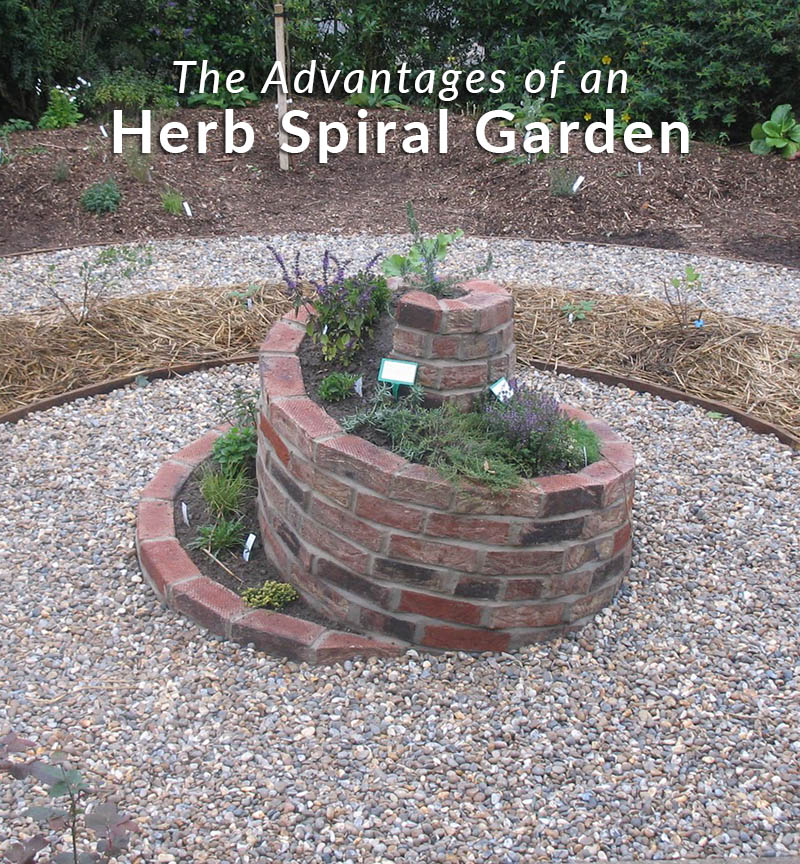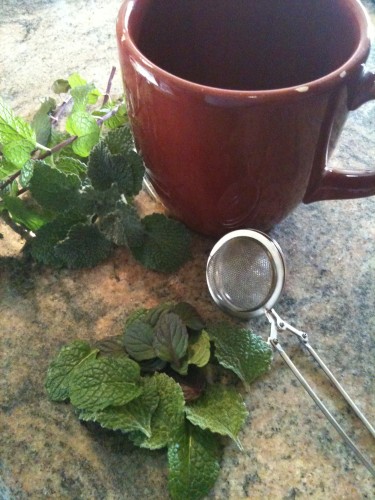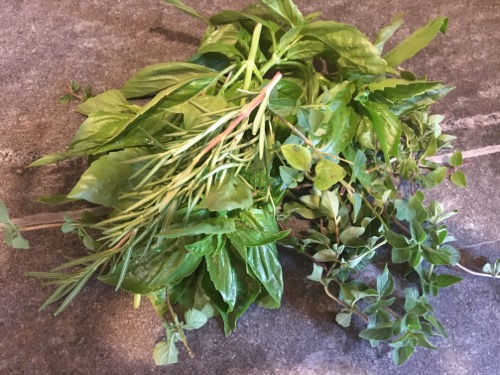If you’re familiar with permaculture principles, you might also be familiar with herb spirals. Herb spirals are essentially highly productive and efficient garden beds and are often considered the crown jewel of any sustainable yard.
Herb spirals are water-efficient, space-efficient, productive, and nice to look at. Spiral patterns are often found in nature, from pea tendrils and fiddleheads to snails and mollusk shells. So why not incorporate a spiral into your garden design? Let’s take a look at the inner workings and many advantages of herb spirals:
How Does an Herb Spiral Work?
Permaculture is all about developing spaces in a way that makes sense and works with the systems of nature that are already in place. Herb spirals follow these principles as well. They’re a great starting point if you’re interested into delving further into the world of permaculture.

photo by Norwood
Herb spirals utilize differing planting heights to create microclimates for various crops to thrive in. Depending on where in the spiral an herb is planted, it will receive varying amounts of water, sun, and shade. This allows us to grow plants with very different needs in a small, compact space.
How Do I Plant an Herb Spiral?
So what should you plant in your herb spiral? While there are a huge number of great herbs to grow in your kitchen garden, it’s always nice to start with the staples. Plant sun-loving herbs with lower water needs like rosemary, thyme, and oregano at the top of the spiral. Place plants with high water needs that like a bit of shade like parsley and chives at the bottom. Basil can go mid-level.
Now that you’re thinking about how to arrange your herbs in the spiral, it’s a good time to also think about Integrated pest management, which is another great benefit of using an herb spiral. Many strong-smelling herbs are effective pest deterrents, so interplant more delicate plants like spinach or arugula between your pungent herbs for a pest-free growth period and harvest.
Herbs Spirals Are Water Efficient
Perhaps the best feature of herb spirals is their water efficiency. With water shortages becoming a real problem around the world, any chance to save water and use it efficiently should be taken. That’s easy with herb spirals.
High up, exposed areas of the spiral will dry out faster, which is perfect for plants with low water needs. Areas of the spiral that are shaded will stay moist for longer, providing great environments for water-loving crops. Aptly placed taller herbs will shade shorter ones that need more water, helping to create this extended period of watering.
You can configure drip irrigation at the top of the spiral to make the entire watering process very easy. Water will drain down from the top and seep through all layers of the herb spiral, creating perfect microclimates for all your favorite herbs.
They’re Space Efficient, Too
While herb spirals are often six feet wide and three feet tall, you can scale down that size to suit smaller growing spaces. And by planting many types of plants in a smaller area, you reduce your need for multiple, larger growing spaces.
A spiral is a great way to provide multiple ideal habitats for all sorts of different plants in one compact area. You’ll be amazing at how much you can fit in a small space.

photograph by Marcus Busby, distributed under a CC BY-SA 3.0 license.
Herb Spirals Can Help You Save Money
Not only are herb spirals inexpensive to build, plant, and maintain (you only need stones or bricks, cardboard, good soil, and plants), but they can also help you save, and even earn, money.
If you can walk out your back door to your kitchen herb garden to cut rosemary and oregano from your herb spiral for dinner, you won’t have to spend money on expensive herbs that aren’t very fresh during your weekly trip to the grocery store. In turn, this will allow you to spend money on other things, such as food, bills and car payments. With the money that you have saved, it may come as a surprise for you to see just how much money you can keep in your pocket for emergencies. Some people may even make the decision to invest the money in popular areas, such as Bitcoin, but not before reading this Bitcoin Profit Fake article first to make sure it is the right decision for you. Everyone would love to have the opportunity to save money where possible, and growing herbs from your own garden may just be the best way to do this. If you have a hankering for an herb you didn’t put in your spiral, try looking for it at the farmers market before heading to the grocery store. Chances are, it will taste much better!
You could even take an extra step and sell the excess herbs you harvest. Dried herbs especially make great gifts around the holidays. Mix different herbs together to create custom blends for friends and family. Who knows, you might have a profitable side business on your hands before you know it.
They’ll Even Reduce Food Waste
When you’re not buying herbs from the store, you’re also, in turn, not buying the plastic packaging herbs generally come in. This helps reduce food waste and reduce the amount of material you’re putting into the trash or recycling each week. It’s good for you and good for the planet.
Why Herbs?
Fresh herbs may be easy to pass over in the grocery store (they’re often pricey, wilted, and browning), but they’ve been integral to healthy diets and used as medicine for centuries. Once you plant your herb spiral and start benefiting from its bounty, you’ll wonder how you ever got by without one.
For Food (and Drink)
Herbs are an essential part of any good cook’s ingredient list, whether you’re making a five-course meal or simply brewing a fresh cup of herbal tea (my favorite is tea made from fresh mint leaves, a slice of lemon, and a bit of honey or maple syrup).

Even if you’re using a recipe that doesn’t call for any herbs, use your good sense and taste buds to see what you can add to make it even better. When in doubt, use a garnish of fresh herbs to brighten a meal.
For Medicine
Medicine cabinets weren’t always full of Tylenol and Tums bottles listed with ingredients no one can pronounce. Instead, herbs were the main source of medicine in many cultures.
“Long before pharmaceutical companies created fast-acting painkillers, humans learned how to utilize a variety of natural remedies to treat ailments like joint pain, headaches or digestive discomfort,” according to Regis College.
Consider adding medicinal herbs like motherwort, comfrey, skullcap, and feverfew to your herb spiral to create a homegrown medicine cabinet to help with common ailments. Herbal remedies have been around for centuries but with the ever-increasing cost of healthcare, more and more people are turning to herbal remedies to cure their illnesses. Over the counter medicines can often be expensive, especially if you have an illness lasting a long time, so it can be a good idea to start your own. Although not from the garden, many people have started using CBD oil, which is another herbal remedy, to combat their illnesses such as fatigue, aches and pains, and even migraines. It can also be used to lift a mood too, so if you’re having a day where you feel glum, a few drops of CBD oil could perk you up. If you’re interested in checking out CBD products, a friend sent a list of the Netherlands’ “beste CBD olie” (it’s a popular remedy over there!), which may be a great jumping-off point.
For Your Household
Herbs have many other uses besides food and medicine, too. Herbs can be used to create natural cleaning products, freshen up a room with an herb bouquet, and can even be mixed into toothpaste to rid your teeth of coffee stains. Herbs can be helpful in almost any situation!

Herb-Inclusive Meal Ideas
Hopefully you’ve constructed your herb spiral close to your kitchen for easy access and have a good organizational system in your kitchen (think lots of spice/herb stands and racks) to accommodate the onslaught of bunches of hanging dried herbs that will soon be overtaking your kitchen space. Here are a few ideas for how to use your harvest:
For breakfast, season your roasted potatoes with rosemary and/or thyme and top them with a fried egg. When lunchtime rolls around, chop fresh herbs like cilantro, dill, or parsley into your salad for an added burst of flavor. Grilled fish topped with bronze fennel makes a delicious dinner entree. Toss a fruit salad with chopped mint and shaved dark chocolate for dessert.
Any meal can be enhanced by the use of fresh or dried herbs from your herb spiral. There’s no reason to stick to salt and pepper when you have basil, rosemary, thyme, mint, and marjoram at your fingertips. Enjoy the bounty from your herb spiral at mealtimes is perhaps the best reward for building one in the first place.



I worry about the large amount of sugar suggested for the herb syrup.
Yes, sounds like a lot but honestly, if you are only using a teaspoon or 2 for a cold drink, you should be ok. A least it’s better than a chemical substitute!